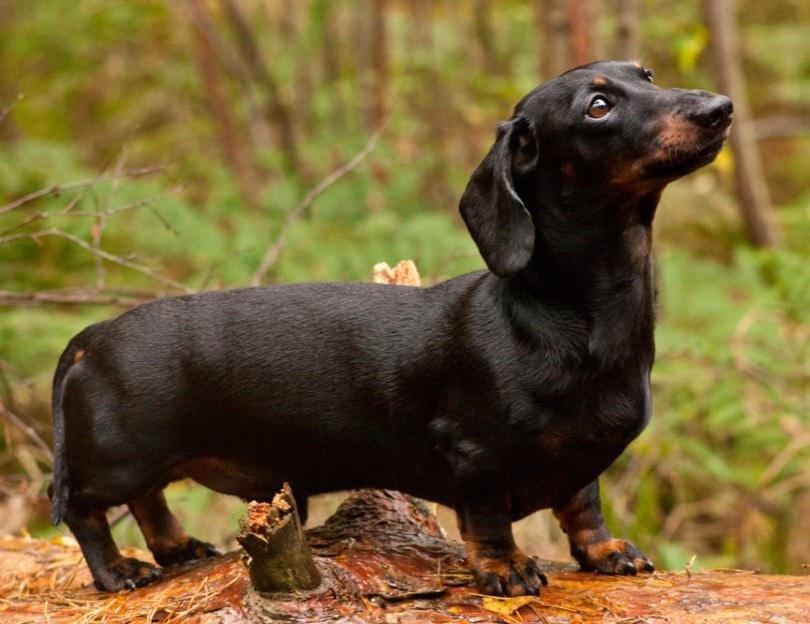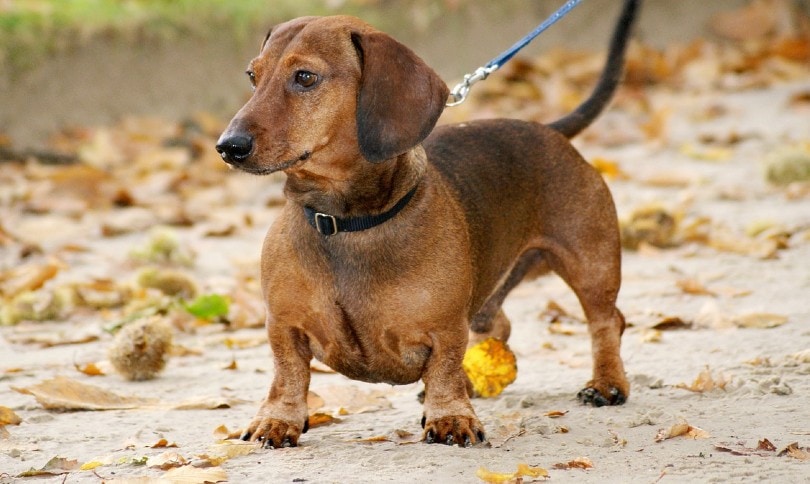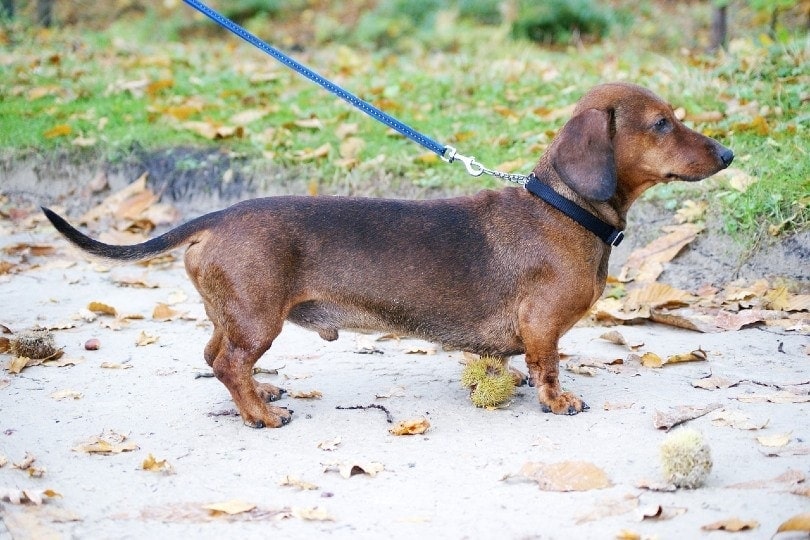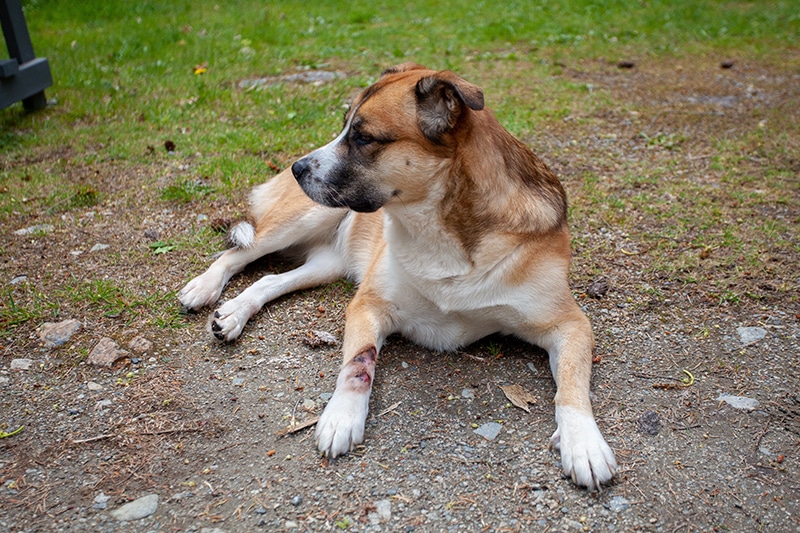How Big Do Dachshunds Get? Dachshund Growth & Weight Chart
Updated on

Click to Skip Ahead
Dachshunds are sometimes called “hot dogs” or “sausage dogs” because of their long bodies that are low to the ground. Although they may be small, they are full of energy and personality. Don’t let their size fool you either — these dogs can make noise! They have loud, deep barks that can sound surprising coming from such a small dog.
These bold dogs are adorable and make great pets, but how big do they get? In this article, we look at a Dachshund’s size and development over the first year of their lives.
Facts About Dachshunds
Dachshunds are part of the scent hound family and were originally bred to hunt tunneling animals. This is how they got their name. In German, “Dachs” means “badger” and “Hund” means “dog.” There are three types of Dachshunds, and they can have one of three coat varieties: short haired, wirehaired, or longhaired.
Standard Dachshunds are between 16 and 32 pounds when they reach adulthood. If they are between 11 and 16 pounds, they are known as a Tweenie, but this is not an official classification. Any Dachshund under 11 pounds is a Miniature. Standard and Miniature Dachshunds are recognized by the AKC.
Even though they were bred as hunting dogs, Dachshunds make loving family pets today. They still retain their prey drives and love to chase anything small and furry, so they may do best in homes without small animals. They love toys and to be around people. These dogs can form deep bonds with their owners.
Common Dachshund coat colors include red, chocolate, black, cream, tan, and blue. Some dogs are patterned, such as brindle or dapple, which has a mottled look. Dachshunds have lively personalities packed into their compact size, making them desired family pets for any household.

Dachshund Growth Chart
While there are three types of Dachshunds, this chart represents the most common type, which is Standard. Standard Dachshunds are recognized by the American Kennel Club, and the breed standard for them has a weight of 16–32 pounds. Standard Dachshunds are considered fully grown at 8–12 months old.
| Age | Weight Range |
| 1 month | 3 – 5 pounds |
| 2 months | 5 – 11 pounds |
| 3 months | 6 – 13 pounds |
| 4 months | 8 – 17 pounds |
| 5 months | 10 – 20 pounds |
| 6 months | 12 – 25 pounds |
| 7 months | 14 – 27 pounds |
| 8 months | 15 – 29 pounds |
| 12 months | 16 – 32 pounds |
When Does a Dachshund Stop Growing?
By the time your Dachshund is 8 months old, you should have a good idea of what their size will be as an adult. Their skeletal development is complete by 12 months old, so they won’t get bigger after that. This is when they’ve reached their full height and length. The growth plates are closed by this point.
However, Dachshunds can fill out after this time. This can continue until they reach 18–24 months. But Dachshunds are prone to becoming overweight quickly. As your dog continues to fill out, watch to make sure they are not putting on too much weight. Keeping your Dachshund at a healthy weight is important for their quality of life.

Factors Affecting the Size of Dachshund
The best way to determine what size your Dachshund will be is to look at the parents. If the parents are large or Standard sized, your puppy will likely be Standard too. If your Dachshund was born to Miniature parents, they will be smaller than the Standard size.
There are three things that can affect your Dachshund’s growth. If you think that they are not developing properly, talk to your veterinarian about possible health conditions that could negatively impact their growth.
For example, parasites can stunt your dog’s growth. If your Dachshund has roundworms or hookworms, these are internal parasitic infestations that prevent your puppy from getting the nutrients that they need. The worms will feed off the food that your dog eats and steal their nutrition. Make sure your puppy gets the proper deworming treatments necessary at their vet appointments.
Malnutrition can also cause growth delays and health problems. Too much or too little food can stunt their growth. Your vet is the best source of information on how much to feed your puppy and how often they should eat.
Avoid exercising your puppy too much while they are still growing. Dachshunds should not overexert themselves before their growth plates are fully developed. Too much high impact exercise can affect these plates and in turn, affect the growth of your dog.
Ideal Diet for Maintaining a Healthy Weight
Dachshunds can quickly become obese if you don’t watch how much you feed them. This can be difficult for your dog because they are so small. Extra weight on their frames can lead to back injuries and limited mobility.
Dachshunds should be fed appropriate portions at each meal. Divide their food for the day into two or three meals so you know that your dog isn’t overeating. It’s easy to give them treats and table scraps, especially if they are begging for them. However, keep these to a minimum to avoid weight gain. You can try bits of carrots, apples, and cooked sweet potatoes as treats to limit the calories that your Dachshund consumes each day.
Talk to your vet about the calorie limit for your dog, and be sure to stick within that range to keep your dog at a healthy weight. Remember to exercise your dog often. Playing with toys or going for a long walk each day will help them burn calories and stay healthy.

How to Measure Your Dachshund
There are three measurements to get to find your Dachshund’s true size. You’ll need a measuring tape.
First, measure your dog from the floor to their withers, which is right between their shoulder blades. This will give you their height. Run the measuring tape along their back, from the shoulder blades to the base of the tail, for the length.
Use a scale to weigh your dog to find out what type of Dachshund you have, if you don’t already know. Anything under 11 pounds by adulthood is considered Miniature.
Final Thoughts
There are three types of Dachshunds: Miniature, Standard, and Tweenie. You can find out which type you have by looking at the provided chart or using a measuring tape and scale to determine their size.
Dachshunds are loving family pets. No matter which type of dog you get, you are bound to have a loyal companion for years to come.
Featured Image Credit: NORRIE3699, Shutterstock












